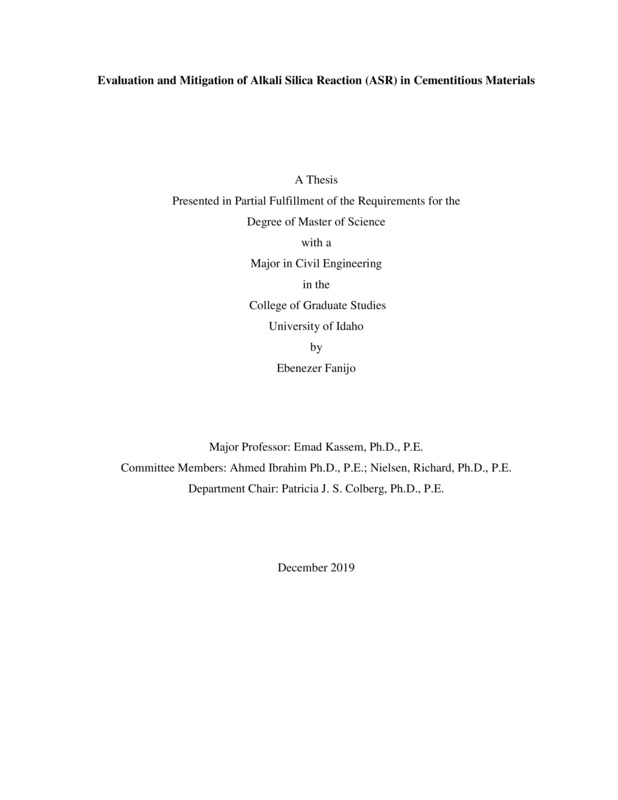Evaluation and Mitigation of Alkali Silica Reaction (ASR) in Cementitious Materials
Fanijo, Ebenezer Oladayo. (2019-12). Evaluation and Mitigation of Alkali Silica Reaction (ASR) in Cementitious Materials. Theses and Dissertations Collection, University of Idaho Library Digital Collections. https://www.lib.uidaho.edu/digital/etd/items/fanijo_idaho_0089n_11730.html
- Title:
- Evaluation and Mitigation of Alkali Silica Reaction (ASR) in Cementitious Materials
- Author:
- Fanijo, Ebenezer Oladayo
- Date:
- 2019-12
- Program:
- Civil Engineering
- Subject Category:
- Civil engineering
- Abstract:
-
Alkali Silica Reaction (ASR) is recognized as a major distress in concrete for over a century. In United States, ASR is a major cause in deterioration of highway concrete structures (i.e., bridges and pavements). Current methods such as the 14-day Accelerated Mortar Bar Test (AMBT) and 1-year Concrete Prism Test (CPT) used to evaluate ASR potential have limitations. Limited research was conducted on new proposed methods such as the 56-day Miniature Concrete Prism Test (MCPT) and 6-month Accelerated Concrete Prism Test (ACPT) proposed to overcome the limitations of existing methods. In addition, there is a need to reduce or mitigate ASR especially in Idaho where 80% of aggregates are reported reactive.
This study conducted comprehensive laboratory evaluation of ASR susceptibility of various aggregates using different test methods. There were strong correlations between the 56-day MCPT method and both the 14-day AMBT and the 1-year CPT methods. Also, the expansion results of the 14-day AMBT method correlated well with the 1-year CPT method. Furthermore, the 6-month ACPT method provided comparable results to the 1-year CPT. these results show the validity of various test methods to evaluate ASR potential. Recommendations were provided to revise the expansion threshold of MCPT to identify reactive aggregates.
The use of Supplementary Cementitious Materials (SCMs) along with glass powder was found to reduce ASR expansion substantially. Binary or ternary blends of 20% replacement of slag, glass powder or silica fume can be used for ASR mitigation without compromising other concrete properties. These results were also supported by the findings of the microstructure and chemical analysis where SCMs were found to reduce the cracks formed in concrete due to ASR expansion.
- Description:
- masters, M.S., Civil Engineering -- University of Idaho - College of Graduate Studies, 2019-12
- Major Professor:
- Kassem, Emad
- Committee:
- Nielsen, Richard ; Ibrahim, Ahmed
- Defense Date:
- 2019-12
- Identifier:
- Fanijo_idaho_0089N_11730
- Type:
- Text
- Format Original:
- Format:
- application/pdf
- Rights:
- In Copyright - Educational Use Permitted. For more information, please contact University of Idaho Library Special Collections and Archives Department at libspec@uidaho.edu.
- Standardized Rights:
- http://rightsstatements.org/vocab/InC-EDU/1.0/

